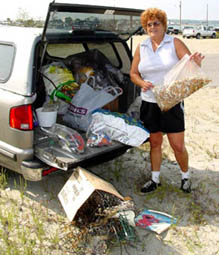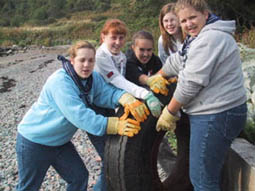
![]()
Volume 6, No. 4
Promoting Cooperation to Maintain and Enhance
Environmental Quality in the Gulf of Maine
|
|
|
|
|
|
|
|
|||||||
|
|
|
|
Browse the archive |
|
|
|
|
Editor’s Notes
Thousands join in to clean-up marine debris
By Andi Rierden, Editor
For those old enough to remember, roadsides across North America in the early 1960s were routinely littered with trash. Lots of it. People thought little about tossing cups, bottles, paper and worse from car windows without a pang of guilt. But now, after years of public education, better litter enforcement and recycling programs, roadways are cleaner (if not yet pristine).
Betty Erickson of Hampton Beach in southern New Hampshire remembers the impact of programs like Keep America Beautiful (and similarly Pitch-In Canada) and has championed their anti-litter ethic ever since. She just wishes everyone else did too.
Erickson knows all too well the litterbugs that use the beach and tidal marshes near her home along the Hampton River: the fishermen that casually toss away their fishing line and lunch wrappers; the teenage beer drinkers that party under the Neil R. Underwood Jr. Bridge; the person that grinds her cigarette butt under her sandal and flicks it out to the water.
“When the tide comes in,” Erickson said, “it all comes up.”
 |
| Betty Erickson Photo: Ron Sher |
“It’s not good for the birds and seals, you know,” she said.
This past fall, Erickson was joined by more than 8,500 like-minded souls throughout the Gulf of Maine, who took part in the International Coastal Cleanup (ICC) sponsored by the Ocean Conservancy. The event is the oldest and largest beach and waterway cleanup with data collection in the world. Volunteers from around the globe participate each year, clearing megatons of trash from coastlines, rivers and lakes.
Ultimately, said Nicole Sandberg, the manager of ICC, the goal of the program is to eliminate the need for cleanups by preventing people and industries from polluting waters in the first place.
During the month of September and October, residents from New Hampshire, Massachusetts, Maine and New Brunswick cleared more than 45 tons of debris from coastal beaches, with each jurisdiction reporting an increase from last year in volunteers and volume of trash collected.
Gay Wittrien, who coordinated the clean-up for the Saint John Atlantic Coastal Action Program in New Brunswick said 400 volunteers collected 4.43 tons of garbage from ten Saint John area beaches, double the amount from last year.
“The interesting thing is that we did not do anything different from last year in regards to volunteer recruiting, which makes me think that maybe people are getting the message that marine debris is unacceptable,” she said.
The Saint John beach sweepers retrieved a refrigerator and stove, TVs, mattresses, bedsprings, computer parts and smaller household items. “A lot of construction material made up the waste stream such as shingles, nails, flooring and carpeting,” Wittrien added. They also found condoms, a doghouse, three shopping carts, a bicycle frame, a respirator, a dead seal and a few dead birds. Volunteers spent the morning picking up debris, then returned to a coast guard shed for lunch and to swap stories.
New Hampshire also exceeded the number of volunteers and trash from 2001. About 1,283 volunteers covering 26.25 miles collected 7,822 pounds of trash.
Some 1,950 volunteers cleaned up in Maine, carrying away 9,770 pounds of trash, along a 127 mile stretch of coast.
In Massachusetts, the Gulf’s most populated state, local business sponsors donated 10,000 gloves and other supplies. Teams of school children, Boy Scouts and Girl Scouts joined in too. All told, the effort brought out 4,149 volunteers who picked up more than 72,970 pounds of trash along 164.7 miles of coastline said Carey Gordon of the Massachusetts Office of Coastal Zone Management.
Most of the debris Gulf-wide came from land-based sources such as beach picnics, fishing, inappropriate or illegal dumping and general littering. As any coastal sweeper will tell you, the results of these throwaway moments can be tragic for seals, birds, fish and other marine animals.
 |
| Clean-up volunteers on beach near Saint John, New Brunswick Photo: ACAP Saint John |
As for humans, discarded hooks or broken glass can seriously injure barefooted beach goers. And it goes without saying, littered beaches trash the image of shoreline communities by giving the message, “we just don’t care.”
The ICC works with a lead coordinator, usually a state agency or non-profit organization, supplying data cards, pencils, posters, education guides and press kits (because of high postage costs, ICC ships out trash bags only to U.S. participants). Once the clean up is over, volunteers record the information. The cards are compiled, analyzed and tracked year by year, revealing patterns in marine debris in a region or country.
“This allows us to see the types of debris and to target user groups–such as fishing, recreational and commercial,” Sandburg said. “From there we can help develop pilot programs on signage along beach areas, for example, or educational materials on effects of debris, which can be used as models in other communities.”
Over the years, Sandburg said, cleanup reports have influenced public policy on waste management, prompted legislation and convinced individuals, organizations and communities to reexamine their waste handling practices.
This year Betty Erickson began her coastal clean up early, on August 30, in memory of her late son Jon. He would have been 23 years old on August 31. “He grew up playing on these marshes all the way up to Turtle Rock,” she said. During those 23 days to September 21, Erickson collected 3,000 cigarette butts and about 100 pounds of debris.
“People learn by example, and when a young kid watches his grandfather throw his garbage in the marsh, that kid is going to do the same thing,” Erickson said. “I’m just hoping that when people see other people picking up trash, they’ll think twice about dropping that candy wrapper or cigarette butt on the beach.”
To view the complete results of this year’s International Coastal Clean-up go to http://coastalcleanup.org/.